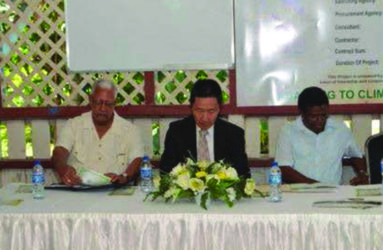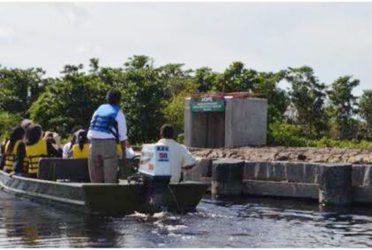A Japan-financed project to fortify the East Demerara Water Conservancy (EDWC) has seen the construction and rehabilitation of six of the network’s 33 intake/relief structures.
GINA said that the project was handed over on Tuesday to the National Drainage and Irrigation Authority (NDIA) at Flagstaff, East Coast Demerara.

The two-phase project was aimed at procuring equipment and rehabilitating facilities for the improvement of the flood-control capacity of the EDWC. The compromising of the EDWC was seen as one of the key factors behind the 2005 Great Flood. Phase one of the project saw the procurement of equipment vital to the maintenance of the conservancy. GINA said that among the items acquired were excavators, aluminum boats and engines, 4 x 4 trucks, GPS devices and laptops.
Phase two which was funded by the Japanese government through the Japanese International Cooperation Agency (JICA) and executed by the Ministry of Agriculture in collaboration with NDIA had been scheduled for completion by March 2016.
The rehabilitation of the conservancy (phase two) had an estimated cost of $771 Million, with the Government of Japan contributing $755 Million and the Government of Guyana’s contribution of $16 Million in kind. In September of 2011, Stabroek News had reported that then Minister of Foreign Affairs Carolyn Rodrigues-Birkett and Japanese Ambassador Tatsuaki Iwata inked a US$3.8m grant agreement for the second component of the EDWC repair work.
GINA said that the just concluded project included construction works at the Shanks and Hope intakes and rehabilitation work at the Hope intake, and Sara Johanna and Maduni sluices, and the Nancy and Annandale intakes.
Minister of Agriculture Noel Holder explained at the handing over of the project that it has realised construction and rehabilitation of six of the network’s 33 intake/relief structures to protect the EDWC Dam from overtopping and collapse during rainy seasons.

The Minister also gave the assurance that “… we are actively working to provide the necessary investments in infrastructure to raise your quality of life through proper drainage and irrigation.” GINA said that he was referring to residents of Region Four.
The Minister said that, “While there is much more to be done” government is resolute in building more relief channels, more sluices to release water into the ocean and rivers, installing more pumps to complement the sluices, and increasing the holding capacity of water conservancies.”
The Ministry of Agriculture, through the NDIA, will pursue aggressive plans for upgrading and rehabilitating drainage and irrigation infrastructure in all regions of Guyana to ensure optimum capacity in the drainage and irrigation system, the Minister further promised.
Acknowledging the contributions of Japan, Holder expressed government’s gratitude for the provision of financial support.
Japanese Ambassador to Guyana, Mitsuhiko Okada said that climate change is a matter of great concern to all. “I would like to commend the efforts of the different agencies involved for bringing the project to completion.
Japan is committed to supporting developing countries in overcoming vulnerabilities and creating strategies to withstand the effects of climate change as evidenced by this grant.”
Chief Executive Officer of the NDIA, Fredericks Flatts said that 20 engineers were recently trained in dam management, flood control and repairs.




